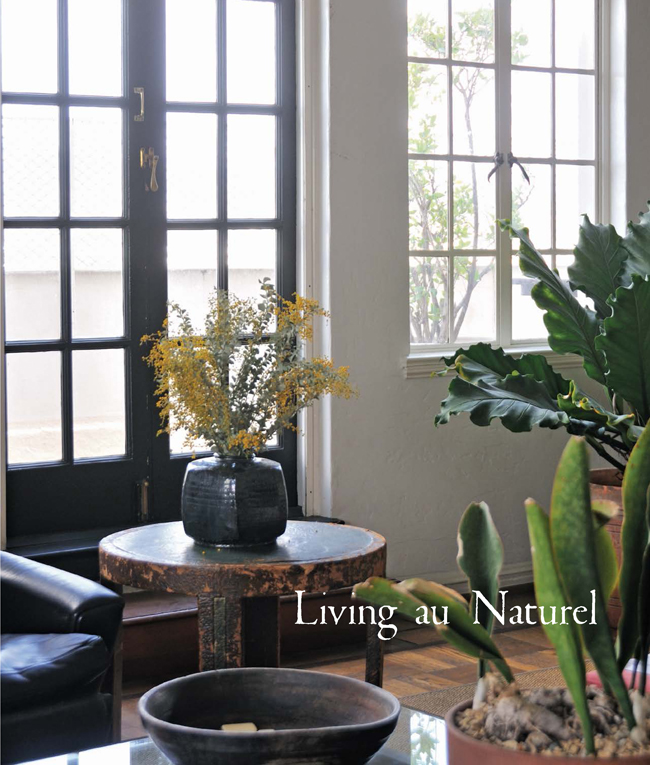

For Emily Brontë, D. H. Lawrence, Willa Cather, and others, everything important begins with the earth. The domestic interiors in their novels resonate with us because they so powerfully embody the values of the landscape around them. These novels show us that by peeling back the layers, we can live simply and authentically. Case in point: in the stark moors of Emily Brontë’s Wuthering Heights we grasp the spiritual beauty of a minimally furnished home. In the description of Thomas Hardy’s gray Wessex twilight we surrender to the allure of a tranquil palette. In the rush of pleasure Anne of Green Gables gets from an armful of autumn branches, we see the vitality that nature can bestow on a room. Look beyond yourself, these authors urge us. It’s only by studying the exterior world that we can discover what makes us truly happy.
This solid walnut island is a powerful reminder that everything begins with the earth.
Plain walnut shelves echo the gardener’s hut “paneled with unvarnished deal” in Lady Chatterley’s Lover.
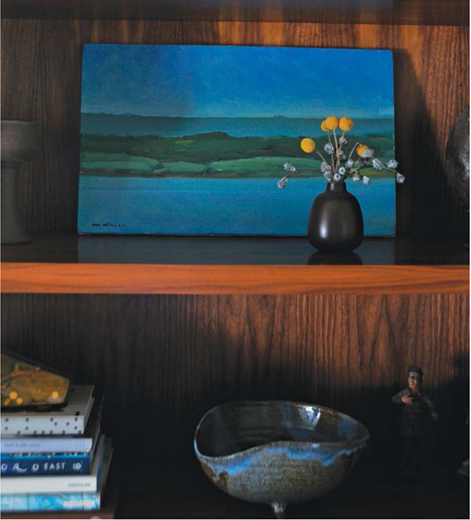
A sky-blue landscape adds vibrancy and dimension to a bookshelf.
Henry David Thoreau had it exactly right when he said, “A man is rich in proportion to the number of things he can afford to let alone.” For the authors in this chapter, when we whittle down our possessions, what remains becomes more sacred. In Walden, Thoreau writes of a house “where you can see all the treasures … at one view, and everything hangs upon its peg that a man should use.”
There’s a serenity to pared-down rooms that comes from the freedom to focus on ideas instead of objects. In his short story “The Captain’s Doll,” D. H. Lawrence describes a room as being beautiful in part because it has “very little furniture save large peasant cupboards or presses of painted wood, and a huge writing-table.” There’s nothing more inefficient than a house filled with things you don’t use—although some people may revel in a space that’s cluttered, for you it doesn’t offer any creative breathing room. Let other people call your rooms plain. To you, they’re well edited and all that you could want.
“The ease that belongs to simplicity is charming enough to make up for whatever a simple life may lack.”
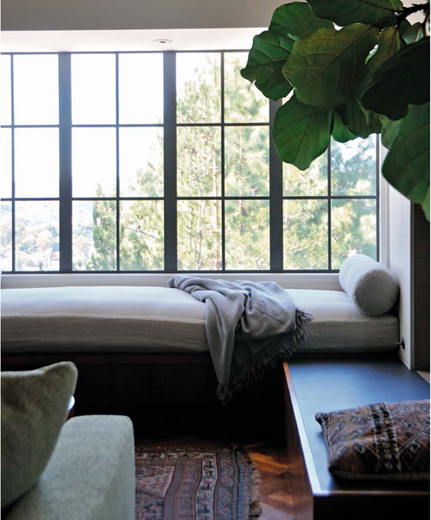
Upholstering a daybed by a window in a calm neutral hue ensures that the Hollywood Hills are the star.
Multipurpose objects allow plenty of room for a more minimal style of living. In D. H. Lawrence’s Sons and Lovers, there’s a trestle table that can easily be moved and taken apart should the area be needed for another activity. A bench that doubles as a seat, a coffee table, and a place to rest your feet is perfect for those looking to emulate the no-frills simplicity of Thoreau’s Walden. This kind of decorating isn’t about following rules; it’s about seeing the versatility in everything and never being afraid to improvise.
Above the madding crowd: twig fencing laid across a simple frame gives an outdoor dining area the appeal of a rustic refuge.
Practical wooden furniture has a plainspoken honesty that makes it all the more distinctive.

Corded walnut chairs give airiness to a dining table and let the view shine through.
Elements like wood, stone, and clay have a spiritual component that fills a home with nature and, thus, life. In Sarah Orne Jewett’s The Country of Pointed Firs, the narrator loves to sit in her room “with the brown unpainted paneling of its woodwork.” Not for these characters the gleam of a highly polished chandelier. They prefer the dull luster of a terra-cotta bowl or the way the sun’s rays reveal the intricate grain of a wooden chair.
“He was a primitive. . . . He seemed to be at the root of the matter; Desire under all desires, Truth under all Truths. . . . [He] was earth and would return to earth.”
Willa Cather,
THE PROFESSOR’S HOUSE
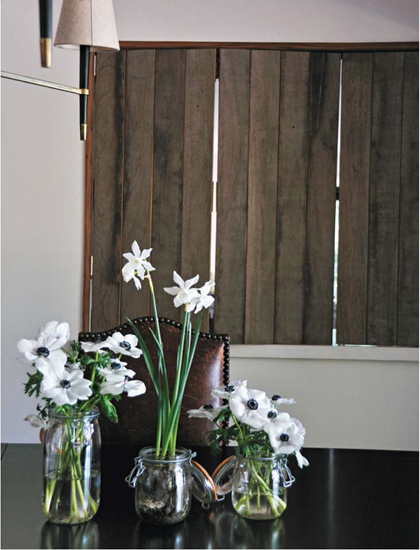
Weathered planks from an outdoor planter have been refashioned into folding doors for a kitchen pass-through.
What is it about wood anyway? Thoreau writes about it in Walden: “It is remarkable what a value is still put upon [it] even in this age and in this new country, a value more permanent and universal than that of gold.” This idea holds just as true today. No other material is so closely intertwined with the culture of humankind—since time immemorial it’s warmed us, sheltered us, and comforted us. Every piece tells its own unique story, so before you repaint that battered old dresser, take another look and see if perhaps it’s more meaningful left just as it is.
Rustic graffiti: Despite its pop art roots, this Andy Warhol piece totally fits in with the owner’s organic aesthetic.
A wooden altar table, oversized candlesticks, and flowering branches radiate a monastic austerity against a sandstone brick wall.

Less is more: A home decorated with a minimal touch gets straight to the heart of the matter.
Stone is at once ancient and modern, dignified and ordinary. In Wuthering Heights, the smooth white stone floors in the manor house lend Heathcliff’s rough-hewn furniture—“high-backed, primitive structures”—a sculptural nobility. Stone floors look wonderful in foyers and mudrooms because they forge an instant connection between indoors and outdoors. When it comes to stone countertops, it’s worth looking into versions that are honed but left unpolished, like granite or soapstone. They won’t remain pristine forever, and that’s exactly the point—with time, they’ll gain a patina that’s rich in personal character.
Accessories can have sacred qualities, too. Classic and unostentatious, earthenware has a mellow glow even under harsh light. Over time it takes on an interesting crackle, or “crazing,” and looks even better when passed down from previous generations—a good reason to scour your local antique shops if you don’t have access to heirlooms. In Sons and Lovers, earthenware is what Mrs. Morel cooks with: “a great bowl of thick red earth.” There are many kinds—majolica, faience, and Delft, for example—but creamware, terra-cotta, and Japanese raku ware have an organic lyricism that’s more in keeping with this rustic style.
Enlightenment from on high: a second-story bookcase keeps the lower half of a room uncluttered.
Open shelving where you can see all treasures at one view reinforces the credo of owning what you love and using what you have.
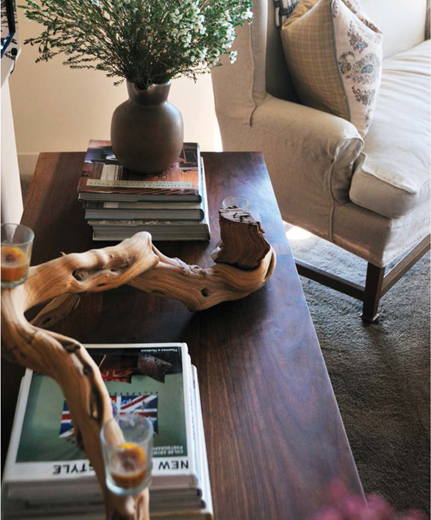
A gnarled branch of driftwood holds candles and is elevated to sculpture on a sideboard.
D. H. Lawrence loathed the dehumanizing effects of modern industry and believed man’s saving grace was his connection with nature. He describes Lady Chatterley as having the vulnerability of a wildflower: “She wasn’t all tough rubber-goods-and-platinum, like the modern girl.” Resist the allure of the new and shiny, he tells us. Fancy silver spoons don’t make a meal taste more delicious.
Shells and driftwood have a primitive delicacy that lends a lovely grace note to a room. In The Country of the Pointed Firs, both of these decorative accessories make an appearance: conch shells brought home from ships’ voyages decorate a mantelpiece, and “pieces o’ wood and boards that drove ashore” are collected by villagers and given a second life in their homes. A gnarled piece of driftwood can make a simple but stunning centerpiece for a table, especially when surrounded by votive candles or trailing ivy. Conch shells also make great pot containers for succulents like jade or aloe, and most nurseries will oblige you by drilling a hole in the bottom for drainage.
A repurposed industrial cart holds salvaged treasures and doubles as a potting bench.
Seagrass matting, flowering branches, and neutral-hued furniture give this room an elegant rustic appeal.
“I don’t want a liddle mop wi’ a handle. I’ve used a thorn twig these fifty years and more, and what was good enough then is good enough now.”

Woven baskets layer a room with texture—in Wuthering Heights, they’re used to store food, firewood, and housekeeping supplies.
Raw nubby textures like straw, seagrass, rush, and willow give the eye another decorative layer to feast on—a good way to add visual interest to rooms without adding color. In Wuthering Heights, Zillah the housekeeper keeps willow baskets in every room for storing food, firewood, and domestic handiwork. In The Country of the Pointed Firs, the villagers sew braided rushes together to make floor mats and thick cushions for a window seat.
“[They] lead rich, emotional lives and . . . live intensely and with a wild poetry.”
Stella Gibbons,
COLD COMFORT FARM
Beauty lies in the unadorned. There’s an appealing candor to plain furniture that was made to perform and not just sit there and look pretty. A sturdy oak table exudes a proletariat strength and simplicity that is key to its raw beauty. In Sons and Lovers, D. H. Lawrence writes of a dwelling, “It had been originally a laborer’s cottage. And the furniture was old and battered. But Paul loved it.” Industrial-style decor is another way of reinforcing this emphasis on function over form—a vintage medical cabinet makes a great liquor bar, for example, and a metal factory stool looks perfectly at home up against a wooden counter.
A LESSON FROM THE BOOKS
SETTING THE RUSTIC TABLE
In The Country of the Pointed Firs, Sarah Orne Jewett describes a rustic feast as beautiful as it is delicious. The villagers trim the edges of the tables with oak leaves and gather wildflowers from the field to create random little rustic bouquets. The result is an unpretentious dinner full of grace and gladness. Below, a few ideas on how to set a table that feeds your spirit as well as your stomach.
• If you don’t have a wooden table, cover yours with a length of undyed burlap—it makes a practical tablecloth for all seasons and looks as appropriate on an outdoor picnic table as it does in the dining room dressed up with bone-handled cutlery and pewter goblets. Buy it by the yard and just cut it to the size you need. Don’t worry about hemming it: the frayed edges add texture and a homespun feeling.
• Instead of plunking down one fancy arrangement in the middle of the table, take inspiration from a field of wildflowers and group small bunches of blooms intermittently along a table. Or scatter ferns and roses along it like Anne does in Anne of Green Gables: “Having … a very artistic taste of her own, she made that tea table … a thing of beauty.”
• Cream-colored pillar candles have a nice heft to them and take on pastoral charm when set inside iron hurricane holders.
• On a buffet table, tie stacks of vintage books together with jute twine and use them as makeshift food trivets and plate stands.
“As I looked up and down the tables there was a good cheer, a grave soberness that shone with pleasure, a humble dignity of bearing.”
Sarah Orne Jewett,
THE COUNTRY OF THE POINTED FIRS

A flea-market table, metal chairs, and trees potted in rolling crates add rusticity to an urban view.
A 1920s greenhouse has been adapted for morning contemplation, craft projects, and candlelit meals.
This little still life derives much of its power from Henry David Thoreau’s entreaty of “Simplicity, simplicity, simplicity!”
When it comes to living with what you love, consider the external world your field guide for inspiration. Think of the decorative bowls of colored leaves and crimson berries on display in Sons and Lovers, the buffalo skins in Willa Cather’s My Antonia, or the cracked blue jug of apple blossoms in Anne of Green Gables. Not all of these accessories will last forever, but that’s okay; it’s all part of a wabi-sabi approach to style, the time-honored Japanese aesthetic that holds transience in high regard and considers impermanence inseparable from what makes something beautiful.
There’s nothing more natural than a palette inspired by the great outdoors, but if you don’t pay close attention, you can end up with a room that’s beige in body and soul. Follow these tips to keep your space from feeling dull or washed out.
• Establish a calm foundation. For big pieces like sofas and chairs, choose something in a neutral color like white, brown, or gray so that you can layer with abandon. It’s all right if your dining table and your chairs are different shades of brown. Subtle variations in woods add depth to a room and prevent it from feeling one-note.
• Energize with contrasts. Tabletop accessories, pillows, and artwork are a great way to introduce color in small doses. If you feel drawn to dense colors, try incorporating pigment-rich accents like persimmon or marigold or apple green to make a brown or gray palette feel even richer. For a more muted option, sage greens, robin’s-egg blues, and soft pinks work beautifully with any neutral palette.
• Amplify with texture. When your palette is restricted, texture becomes a crucial factor in keeping a room looking interesting. Coarse materials like burlap, wicker baskets, a seagrass rug, or rush matting add a pleasing visual tension to the flat nap of cotton or linen. If your furnishings swing toward the rough side already, then take the opposite route: add something smooth like raw silk or plush like cotton velvet to offset it.

In Cold Comfort Farm, the characters have a kinship with nature that goes far beyond a passing fancy: “[They] live intensely and with a wild poetry,” writes author Stella Gibbons. And in Tess of the d’Urbervilles, Thomas Hardy writes of people who “preferred sermons in stones to sermons in churches.” Like them, you, too, can find artistic inspiration in Mother Earth. A bowl of pinecones mixed with some brilliant fall leaves is all you need to create a seasonal centerpiece. Even the most ordinary of objects deserves a place of honor, so arrange shells and feathers into artful patterns on a table. Remember that a pretty branch leaning up against a wall can have the personality and impact of a painting.
“Wreaths of cottage flowers, like chains of little gems, hung from the rafters. Their reds, oranges, blues and pinks glowed against the soft, sooty-black of the ceilings and walls.”
Stella Gibbons,
COLD COMFORT FARM
Back before aspirin and antibiotics, people used natural remedies to treat common ailments like heartburn, colds, and indigestion and landscaped their outdoor spaces to serve such purposes. In Sons and Lovers, Mr. Morel has a simple garden full of medicinal herbs like horehound, wormwood, and dandelion. Growing your own herbs for healing teas is a wonderful way to connect to the soil, do something beneficial for yourself, and bring greenery indoors. Below, a list of plants easy to grow in a variety of pots and containers—no backyard required, just perhaps a sunny window.
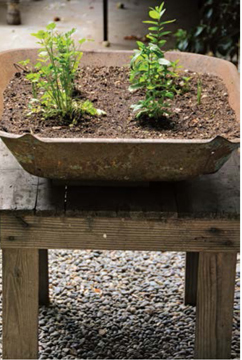
Private viewing: Artwork taped to shelf edges turns a bookcase into an instant art gallery.
This glass and wood Chemex coffee maker fits D. H. Lawrence’s aesthetic of owning only “solid worthy stuff that suit[s] an honest soul.”
Old tin mail pouches are given new life as backyard planters.
Have you fallen in love with the plainspoken honesty of this style? Here’s a checklist of accessories to bring a rustic feel to your space.
| Enamel steel dishware | Welsh blankets |
| Leather cabinet pulls | Sheepskin rugs |
| Wooden pegboards | Wool army blankets |
| Pewter jugs | Patchwork quilts |
| Sailor’s-knot doorstops | Ammonite fossils |
| Trestle tables | Geode bookends |
| Seagrass, jute, and apple floor matting | Steel apothecary cabinets |
| Wooden breadboards | Mason Cash mixing bowls |
| Cast-iron cookware | Vintage wire egg baskets |
| Duck canvas aprons | Leather butterfly chairs |
| Glass mason jars | Horn-handled cutlery |
| Braided rugs | Cork accessories |
| Wire-mesh food domes | Steel Kik-Step stool |
| Nautical landscapes | Straw whisks and brooms |
| Old daguerreotypes | Natural-fiber table mats |
| Gingham | Firewood baskets |
| Iron weathervanes | Leather pot holders |